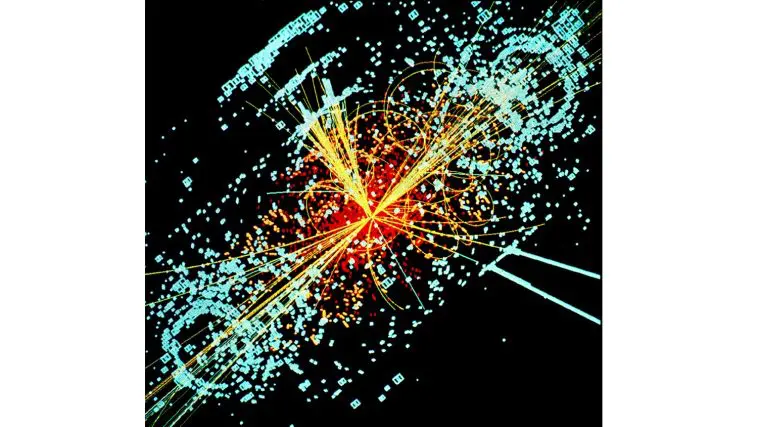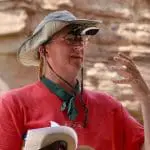[Originally published in 2014 at Darwin, Then & Now Click HERE for image credit]
After spending more than $6 billion on constructing the particle collider in Western Europe, known as the Large Hadron Collider (LHC), searching to solve physics’ greatest mysteries, the evidence seemingly points to one astounding fact — “the universe shouldn’t exist.”
Physicists Peter Higgs and François Englert, working on the most expensive experiment in the history of science, were awarded the 2012 Nobel Prize in Physics for the discovery of the long sought-after Higgs boson, or Higgs particle, which is pivotal to the Standard Model of physics. While the evidence continues to validate the existence of the particle, ironically the evidence may unravel the Big Bang theory for the origin of the universe.
Unknown Element
Higgs’s original calculation in 1964 predicted that some unknown element must exist to account for the mass and electromagnetic properties of the particles forming the universe. The particle was thought to be the ultimate mystery of the universe. The particle eventually became popularly known as the “God particle” from a 1993 book.
In a paper published in Physical Review, however, physicists Malcolm Fairbairn and Robert Hogan of King’s College London, UK, estimate the probability of a “catastrophic destabilizing” effect during the inflation period in the early universe — collapsing rather than expanding the universe.
In other words, the universe shouldn’t exist.
According to Tia Ghose, a LiveScience staff writer,
Modeling conditions soon after the Big Bang suggests the universe should have collapsed just microseconds after its explosive birth.
During the early universe, we expected cosmic inflation — this is a rapid expansion of the universe right after the Big Bang,” said Hogan using the Standard Model of physics. “This expansion [however] causes lots of stuff to shake around, and if we shake it too much, we could go into this new energy space, which could cause the universe to collapse.
Breakneck Speeds
Hogan explained to Ghose that “during the fiery flash after the primordial Big Bang explosion, matter raced outward at breakneck speeds in a process known as cosmic inflation. This bent and squeezed space-time, creating ripples known as gravitational waves that also twisted the radiation that passed through the universe.”
In the paper, Higgs and Englert calculate the probability that these ripples may be large enough to have collapsed the expanding universe.
Information collected by the National Science Foundation telescope at the South Pole, called the Background Imaging of Cosmic Extragalactic Polarization (BICEP2), supports the prediction of these ripples by its detection of the background microwave radiation pervading the universe. By building on an understanding of cosmic inflation properties and the mass of the Higgs boson measured from the new LHC experiments, Hogan and Fairbairn, were able to test the probability of developing these adverse ripple conditions in the wake of the Big Bang.
According to Ghose,
What they found was bad news for, well, everything. The newborn universe should have experienced an intense jittering in the energy field, known as quantum fluctuation. Those jitters, in turn, could have disrupted the Higgs field, in essence rolling the entire system into a much lower energy state that would make the collapse of the universe inevitable.
The universe shouldn’t exist.
New Physics
“So if the universe shouldn’t exist, why is it here?” asks Ghose. “The generic expectation is that there must be some new physics that we haven’t put in our theories yet, because we haven’t been able to discover them,” Hogan said. The missing element, according to Hogan, may require moving beyond the Standard Model for a “theory of supersymmetry” that uses “superpartner particles for all the currently known particles.”
Fairbairn and Hogan are not the first physicists that have said the “Higgs boson spells doom for the universe,” Ghose reported. “Others have calculated that the Higgs boson’s mass can result in a fundamentally unstable universe.”
The mass of the Higgs boson is about 126 times that of the proton; that turns out to be “right on the edge,” in terms of the universe’s stability, said Sean Carroll, a physicist at the California Institute of Technology, to Ghose. Carroll is the author of the 2012 book entitled The Particle at the End of the Universe: How the Hunt for the Higgs Boson Leads Us to the Edge of a New World. “A little bit lighter, and the Higgs field would be much more easily perturbed.”
Since “We are here talking about it,” Hogan told LiveScience, “That means we have to extend our theories to explain why this didn’t happen.” Alan Boyle, science editor for NBC News, in the article entitled “Higgs Boson Picture Becomes Clearer as LHC Gears up for Restart,” uses the term “Higgs-like particle” to skirt increasing uncertainty.
The Higgs boson is thought to be part of the mechanism that gives rise to the masses of all the fundamental subatomic particles. It’s the last piece of one of the scientific world’s most successful theories, known as the Standard Model of particle physics, to be nailed down,” Boyle explains. “But to make sure the theory stays nailed down, physicists want to show that the boson behaves as theory suggests it should.
Markus Klute, an assistant professor of physics at the Massachusetts Institute of Technology (MIT) and leader of the international effort, told Boyle: “Within the current level of precision, there is still room for other models with particles that look like the Standard Model Higgs, so we need to accumulate more data to figure out if there is a deviation, although if we do find a deviation from the Standard Model, it is likely to be a very closely related one.”
The universe shouldn’t exist, but it does — intensifying the Darwin Dilemma.
Genesis
The latest evidence from the LHC demonstrates that the discovery of the natural laws to account for the origin of the universe continues to remain beyond the certainty of science. While a natural mechanism to explain our existence still does not exist, the available evidence is compatible with the Genesis account.
Even Charles Darwin recognized the daunting task of discovering a natural mechanism for the origin of the universe:
The mystery of the beginning of all things is insoluble by us, and I for one must be content to remain an agnostic.







